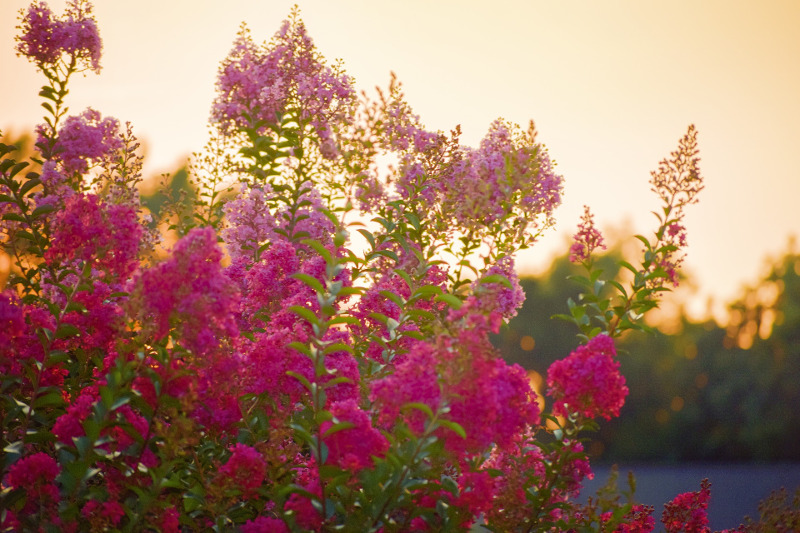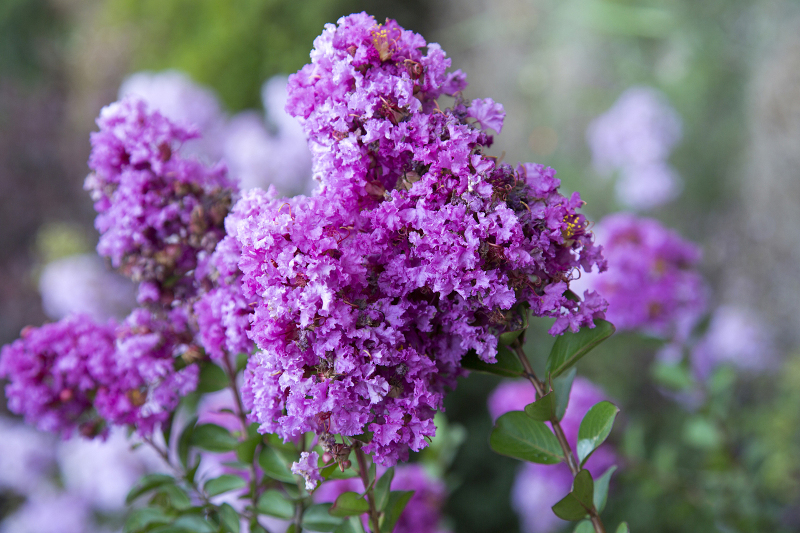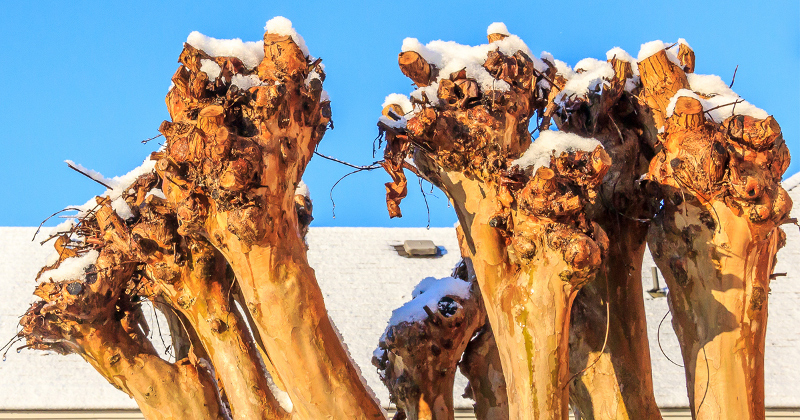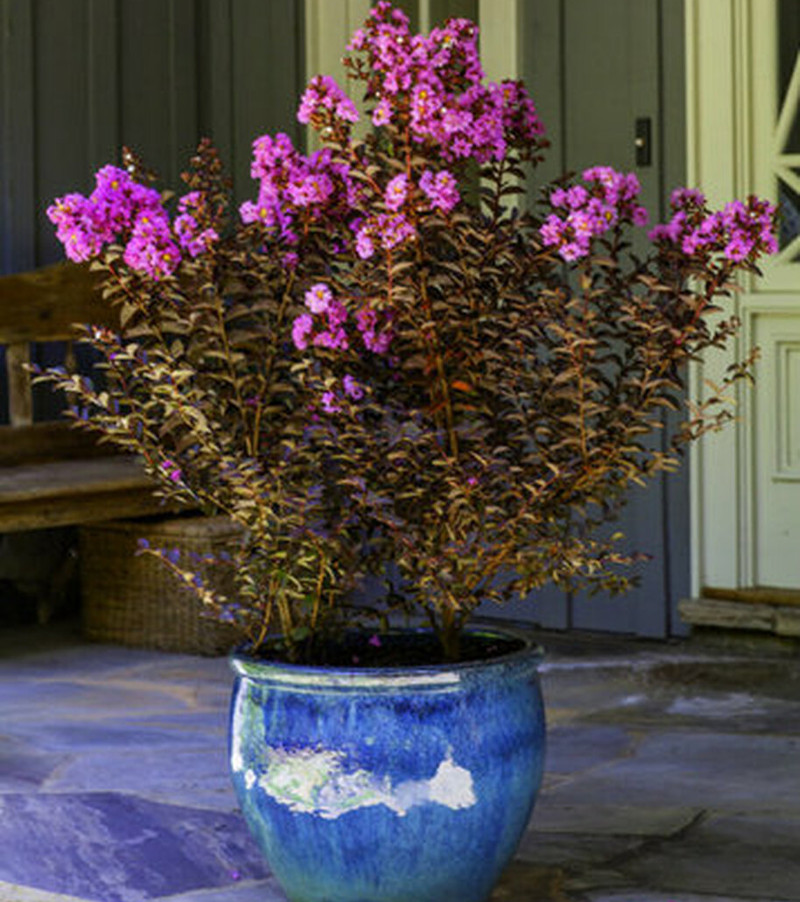With their glossy foliage, exfoliating bark and showy flowers, Crape Myrtles are the stars of boulevards throughout the American South. Lagerstroemia indica – which has earned the Royal Horticultural Society’s Award of Garden Merit is from India and has been recently hybridized with L. faurei from Japan to increase mildew resistance. Cultivars can be shrubs the size of a footstool, or trees 20-30 feet tall. Full sun.
Summer-blooming in white, red, pink, or purple, some varieties keep the show going until a frost. Some varieties are invasive seeders in certain locations, so check with your local extension office before planting. They are variously spelled “crape” or “crepe” myrtle. Because of their year-round interest, they work well used as accent plants, a deciduous hedge, or an allée. Their polite root system makes them perfect street trees.

Crape Myrtle or Crepe Myrtle?
From our research, it appears that there is no right or wrong way to spell Lagerstroemia (Crape Myrtle, Crapemyrtle, Crepe Myrtle, or Crepemyrtle). The plant is also commonly known as the "lilac of the South" in the United States. In southern states, it is most often referred to as Crepe Myrtle. in northern states it is spelled Crape Myrtle. It is also important to know that Lagerstroemia is not related to Common Myrtle (Myrtus communis).
According to Google, Crepe Myrtle is searched the most each month throughout the United States and Worldwide:

According to renowned plant expert, legendary horticulturist and professor of horticulture at the University of Georgia, Dr. Michael A. Dirr, it is spelled "crapemyrtle". The American Crape Myrtle Society spells it with the 'a' instead of 'e'.
The traditional way to spell it in the United States seems to be "crape" with an "a", even though more people search it by "crepe" in Google. For consistency, we've chosen to spell it "crape myrtle" throughout our website.
Planting Crape Myrtles
A full sun location with six hours or more of sun is best for Crape Myrtles – less sun decreases their bloom power. Soil should be well-draining, and on the acidic side with a pH of 5.5-6.5. Plant in a hole as deep and twice as wide as the root ball, with the crown slightly above soil level, and water well through the first two growing seasons.
Watering Crape Myrtles
Water well during the first two growing seasons to allow your Crape Myrtle to become established. Thereafter, they are relatively drought tolerant and regular deep watering once or twice a week should be enough barring extreme weather conditions. Plants in containers will need watering more often. Mulch will help retain moisture and warmth, especially in climates that are drier or colder.

Fertilizing Crape Myrtles
Crape Myrtles are rather hungry feeders while blooming. In the first year, fertilize lightly monthly. Once established, apply a light feeding twice monthly from spring through summer. Water well after fertilizing. If soil is too alkaline, leaves may turn yellow. If a soil test confirms your soil is too alkaline, consider adding iron chelate or other acidifying fertilizer.
Pruning Crape Myrtles
Often overpruned by topping, or trimming in a horizontal line across the top, – a tactic called “Crape Murder,” there are ways to ensure bountiful blooms while retaining the natural vigor and grace of this plant. Prune while your plant is dormant in winter before new growth emerges. Shrubs can be thinned out as needed for air circulation.
For multi-trunk trees prune out crowded interior or crossing branches – keep the center open. For single-trunk trees, prune side branches competing with the main leader as well as sprouts coming from the base. Deadhead any spent flowers to encourage renewed flushes of bloom.

Caring For Crape Myrtles in Pots
Compact varieties of crape myrtles do well in containers, provided the container is big enough to suit the plant while also insulating its roots in winter. Choose a pot with drainage and high-quality potting mix. Pot-grown Crape Myrtles will need more regular watering and fertilization. In the first year, fertilize lightly monthly.
Once established, apply a light feeding twice monthly from spring through summer. Watering may be done three times a week or more, especially during the first two years while getting established. Mulching will help retain soil moisture and keep the roots warm, but if you are growing in zone 6 or below, consider protecting the pot in winter by wrapping it with frost cloth or burlap.

Winter Care for Crape Myrtles
Add compost or organic amendments to the soil in fall. Mulching will help retain soil moisture and keep the roots warm, but if you are growing in zone 6 or below, consider protecting the pot in winter by wrapping it with frost cloth or burlap. Prune as needed while your plant is dormant in winter before new growth emerges.
Crape Myrtles For Sale
Common Crape Myrtle Care Questions
What Are The Crape Myrtle Diseases?
Powdery mildew, sooty mold, aphids, Japanese beetle, and Cercospora leaf spot, are the diseases and pests that most often compromise the health and well-being of crape myrtle.
Difference Between Crape Myrtle Bush vs Tree?
Really the difference is the mature size of the crape myrtle and how you choose to prune, or not prune them. They can be trimmed to grow into multi-trunk or one trunk trees or left to grow naturally and be more bush-like. There are varieties of crape myrtle that grow 2-5 feet tall and some that can reach up to 30 feet tall.
What Are The Crape Myrtle Flower Colors?
The colors in which crape myrtle is available just about run the gamut. They come in white, lilacs, purples, and a wide range of shades of pink and red.
What Is The Growth Rate For Crape Myrtle?
Of course, there are many variables that affect the growth rate of plants, but in general crape myrtle are fast growers and can shoot up to more than 2 feet annually!
Are Crape Myrtle Invasive?
Crape Myrtle is indeed listed on the United States Invasive Plants Atlas, because they produce easily dispersed and sown seeds and when allowed to grow, can easily choke out native growth.
Do Crepe Myrtle Spread?
The roots of crape myrtle can horizontally spread up to three times the size of the canopy of the tree. The roots are fibrous and shallow and allow they reach far and wide, they are not aggressive and they are weak and will not burrow into sidewalks or foundations. The roots of the crape myrtle are so shallow, they may even compete with the water needs of the lawn or other nearby flowers and plants.
Crape Myrtle Not Blooming?
If your crape myrtle isn't blooming, there are a few things to check, that may help! Was it pruned properly? Myrtles should be trimmed right after they're done blooming for the season, so as to avoid cutting off next year’s blooms (they bloom on new growth.) Make sure your myrtle is getting plenty of sunshine and check your soil, the cause could be a lack of phosphorus or too much nitrogen.
Are Crape Myrtle Invasive?
Crape Myrtle are indeed listed on the United States Invasive Plants Atlas, because they produce easily dispersed and sown seeds and when allowed to grow, can easily choke out native growth.
Have a question about Crape Myrtle? Fill out the form below and we will try and get back to your question as soon as possible. We may even feature your question on this article to help other gardeners!
 |
Author Erica Browne Grivas - Published 08-02-2021 |
